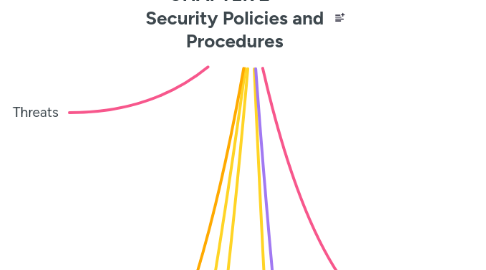
1. STEPS TO PROTECT DATA
1.1. Apply Software Updates
1.2. Protect Passwords
1.3. Disable Lock- Screen Notifications
1.4. Lock Your Apps
1.5. Keep Your Browsing to Yourself
1.6. Encrypt Your Data
1.7. Back It Up
2. Opportunities
3. Threats
4. Requirements of Security Policy and Procedures
4.1. IDENTIFY ALL OF A COMPANY'S ASSETS
4.2. IDENTIFY POTENTIAL THREATS TO THOSE ASSETS
4.3. UPDATED REGULARLY
5. Security Policy
5.1. Requirements of Security Policy
5.1.1. Identify organizational issues that impact information security policy
5.1.2. Identify the various classes of policy users
5.1.3. Organize information security policies and standards into meaningful categories
5.1.4. Review draft policies and standards with management, users, and legal counsel
5.1.5. Train all personnel in the organization’s information security policies and standards
5.1.6. Enforce the information security policies and standards
5.1.7. Review and modify policies and standards, as appropriate but at least annually
6. SECURITY PROCEDURES
6.1. Procedures are detailed step-by-step tasks
6.2. Procedures are considered the lowest level in the policy chain and provide detailed steps for configuration and installation issues.
7. COMMON COMMUNICATION ENCRYPTION TYPES
7.1. Symmetric Encryption
7.2. Asymmetric Encryption
7.3. Hash Encoding
8. Weakness
8.1. Lack of facilitites
8.1.1. No Cyber Security Lab
8.1.2. Slow Internet Connection
8.1.3. Lecturer's PC too slow
9. HOW TO MAKE IT EFFECTIVE?
9.1. Update it in response to changes in your company
9.2. Update from previous breaches
9.3. Update changes to any new threats
10. PASSWORD REQUIREMENTS
10.1. ENFORCE PASSWORD HISTORY
10.2. MINI/MAX PASSWORD AGE
10.3. MINIMUM PASSWORD LENGTH
10.4. COMPLEXITY REQUIREMENTS
10.5. COMPLEXITY REQUIREMENTS
10.6. RESET PASSWORD
10.7. USE STRONG PASSPHRASES
10.8. PASSWORD AUDIT
10.9. E-MAIL NOTIFICATIONS
10.10. STORE PASSWORD USING REVERSIBLE ENCRYPTION FOR ALL USERS POLICY
11. ENCRYPTION TECHNOLOGY
11.1. ENCRYPTION
11.1.1. Encryption is the method by which information is converted into secret code that hides the information's true meaning
11.2. CIPHER TEXT
11.2.1. In cryptography, cipher text (ciphertext) is data that has been encrypted.
11.3. DECRYPTION
11.3.1. Encryption is the process of encoding information.
11.3.2. This process converts the original representation of the information, known as plaintext, into an alternative form known as ciphertext.
11.4. CRYPTANALYSIS
11.4.1. Cryptanalysis is the study of analyzing information systems in order to study the hidden aspects of the systems.
